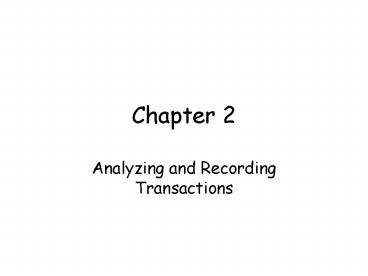Analyzing and Recording Transactions - PowerPoint PPT Presentation
1 / 33
Title:
Analyzing and Recording Transactions
Description:
Analyze each transaction and event from source documents ... Key Terms p. 72 (glossary on web) Multiple Choice Quiz p. 73. Discussion Questions p. 73 ... – PowerPoint PPT presentation
Number of Views:152
Avg rating:3.0/5.0
Title: Analyzing and Recording Transactions
1
Chapter 2
- Analyzing and Recording Transactions
2
Accounting Cycle
- Analyze transaction
- Journalize
- Post
- Prepare unadjusted trial balance
- Adjust
- Prepare adjusted trial balance
- Prepare financial statements
- Close
- Prepare post-closing trial balance
3
Analyzing and Recording Process
C 1
4
Source Documents
- Identify and describe transaction and events
entering the accounting process (e.g. sales
tickets, checks, bills from suppliers, etc). - AKA economic events that affect the financial
- position of a business (the raw material of
- accounting reports)
- Each transaction affects at least two accounts
- For each transaction, the sum of the debits
always equals the sum of the credits (called
Double Entry Accounting)
5
The Account and its Analysis
- Account a record in an Accounting System that
shows increases and decreases in each financial
statement item - General ledger AKA ledger a group of accounts
for a business entity.
6
Ledger and Chart of Accounts
- A companys size and diversity of operations
affect the number of accounts needed
7
Debits and Credits
- T-account is a ledger account and is a tool
used to understand the effects of one or more
transactions - Example of a T Account
- Account Title
8
Normal Balances of Accounts
- ? ? ? ?
- Assets Liabilities BS
- Withdrawals Capital (OE) SOE
- Expenses Revenue IS
9
Normal Debit Balance Accounts ( Left entries ?
balance /right entries ? balance )
- A Assets - resources owned by the business
entity ( cash, land, accounts receivable,
supplies, prepaid insurance, equipment, etc) - W Withdrawals - the amount of withdrawals made
by the owner for personal use (AKA drawing) - E Expenses - using up of assets or consuming
services in the process of generating revenues
(wages, rent, insurance, supplies, utilities,
vehicles, miscellaneous, etc)
10
Normal Credit Balance Accounts ( Left entries ?
balance /right entries ? balance )
- C Capital - the owners right to the assets of
the business (referred to as Owners Equity for
proprietorships and retained earnings for
corporations) - L Liabilities - debts owed to creditors (any
payables such as notes, interest, wages or any
unearned revenues which are future service
commitments such as rent, interest, insurance,
magazines, memberships, etc) - R Revenues - increases in owners equity
resulting from sale of goods and/or services - (fees earned, sales commissions, professional
fees, interest, rent, subscriptions, etc.)
11
Double-Entry Accounting
C 5
- An account balance is the difference between the
increases and decreases in an account. - Notice the T-Account
12
Journalizing and Posting Transactions
- Journal transactions are initially recorded as
debits and credits in the Journal - Process is called Journalizing
- Ledger debits and credits are transferred from
the Journal to each account in the Ledger - Process is called Posting
13
Journalizing Posting Transactions
P1
14
Journalizing Transactions
P1
15
Balance Column Account
P1
- T-accounts are useful illustrations, but balance
column ledger accounts are used in practice.
16
Posting Journal Entries
P1
1
Identify the debit account in ledger.
17
Posting Journal Entries
P1
2
Enter the date.
18
Posting Journal Entries
P1
3
Enter the amount and description.
19
Posting Journal Entries
P1
Enter the journal reference.
4
20
Posting Journal Entries
P1
5
Compute the balance.
21
Posting Journal Entries
P1
Enter the ledger reference.
6
22
Analyzing Transactions
A1
301
23
Analyzing Transactions
A1
24
Analyzing Transactions
A1
25
Analyzing Transactions
A1
26
Analyzing Transactions
A1
101
403
27
After processing its remaining transactions for
December, FastForwards Trial Balance is prepared.
P2
28
Six Steps for Searching for and Correcting Errors
P2
If the trial balance does not balance, the
error(s) must be found and corrected.
?Make sure the trial balance columns are
correctly added.
?Recompute each account balance in the ledger.
?Make sure account balances are correctly entered
from the ledger.
?Verify that each journal entry is posted
correctly.
?See if debit or credit accounts are mistakenly
placed on the trial balance.
?Verify that each original journal entry has
equal debits and credits.
29
Income Statement
P3
30
Statement of Owner's Equity
P3
FASTFORWARD
31
Balance Sheet
P3
32
Debt Ratio
A2
- Describes the relationship between the amounts of
the companys liabilities and assets. - Helps to assess the risk that a company will fail
to pay its debts.
33
Homework
- Read Chapter 2
- Read and answer the Decision Maker and Decision
Ethics questions - Read and answer the Quick Checks
- Visit the Publishers website tools for Ch 2
- Key Terms p. 72 (glossary on web)
- Multiple Choice Quiz p. 73
- Discussion Questions p. 73
- P 2-1A p.79 P 2-3A p. 80































